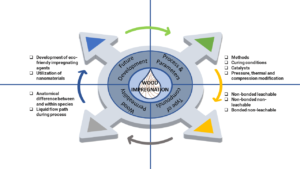Volume 18 Issue 2
Latest articles
- Reviewpp 4332-4372Augustina, S., Dwianto, W., Wahyudi, I., Syafii, W., Gérardin, P., and Marbun, S. D. (2023). “Wood impregnation in relation to its mechanisms and properties enhancement,” BioResources 18(2), 4332-4372.AbstractArticlePDF

The principle of wood impregnation entails treating wood with a monomer/impregnating agent that diffuses into the cell walls, often followed by polymerization to change desired properties. Numerous studies related to this matter have been reported and continue to attract more interest, as wood impregnation can significantly improve wood properties. These processes can be grouped into two approaches: active modification involves the chemical alteration of wood structure by cross-linking, and passive modification features filling of cell cavities and/or cell walls with impregnating agents without any chemical reaction taking place. Wood impregnations could have resulted in an increase in its weight gain due to impregnating agents filling its cavities. It will diminish the utilization of wood as an engineering material in selected application fields. Owing to the extensive literature available, this article summarizes the representative achievements of wood impregnation. The mechanisms, benefits, and drawbacks of various impregnating agents on wood properties, along with grouping the impregnating agents that cause greater or lesser weight gain of wood were analyzed, compared, and evaluated. Thus, according to the application state of wood impregnations, the problems existing in those processes and the developmental trends in the future are also discussed in this review.
